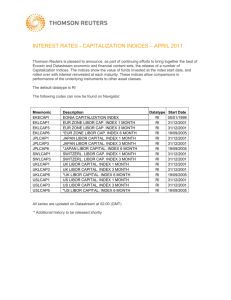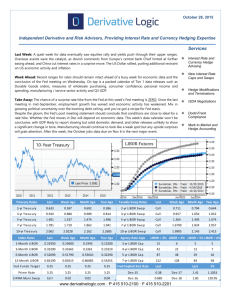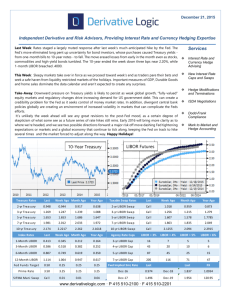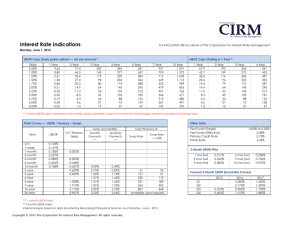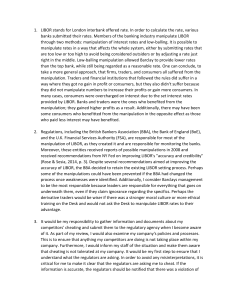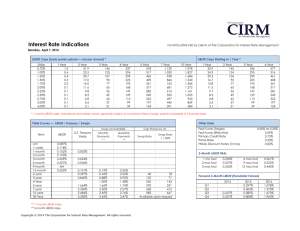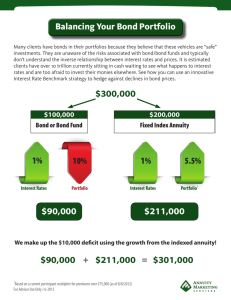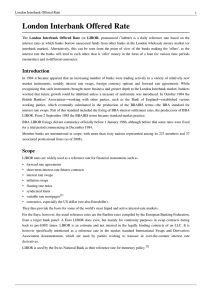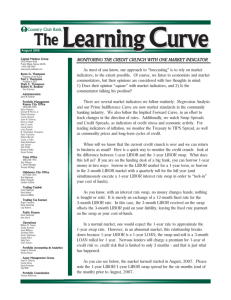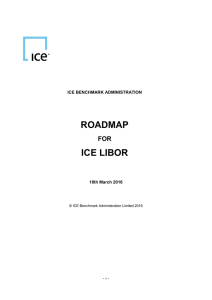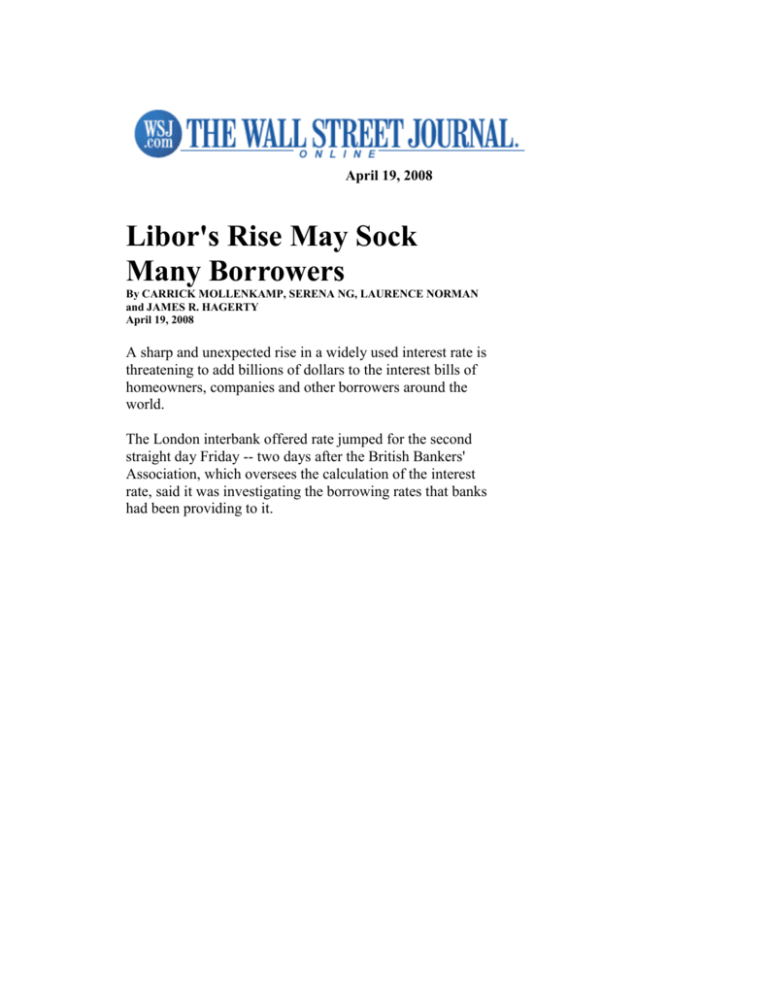
April 19, 2008
Libor's Rise May Sock
Many Borrowers
By CARRICK MOLLENKAMP, SERENA NG, LAURENCE NORMAN
and JAMES R. HAGERTY
April 19, 2008
A sharp and unexpected rise in a widely used interest rate is
threatening to add billions of dollars to the interest bills of
homeowners, companies and other borrowers around the
world.
The London interbank offered rate jumped for the second
straight day Friday -- two days after the British Bankers'
Association, which oversees the calculation of the interest
rate, said it was investigating the borrowing rates that banks
had been providing to it.
The BBA started its review amid growing concerns among
bankers that their rivals weren't reporting their true high
borrowing costs, for fear of signaling to the market they
were desperate for cash. John Ewan, a manager of the Libor
system at the BBA, said Friday the association continues to
believe in the accuracy of the Libor system.
Libor is one of the world's most important financial
indicators. It serves as a benchmark for $900 billion in
subprime mortgage loans that adjust -- typically every six
months -- according to its movements. Companies globally
have nearly $9 trillion in debt with interest payments
pegged to Libor, according to data provider Dealogic.
If sustained, the past week's rise of Libor could add roughly
$18 billion in annual interest costs on that corporate debt,
or about $100 to the monthly payment on a $500,000
adjustable-rate mortgage loan.
John Waite, a mortgage broker in Appleton, Wis., said one
of his customers, a house painter, faces a reset on his
subprime loan next month and will be affected by the recent
Libor gyrations. The painter's interest rate was fixed at
7.25% for the first three years of the loan, and next month
the borrower will make its first adjustment based on a
margin of 6.5 percentage points over six-month Libor.
With that rate around 3%, the painter's new monthly
payment of interest and principal would be about $1,446,
Mr. Waite said, up from the current $1,173. Six-month
Libor was around 2.7% Monday. At that rate, the painter's
new payment would be $1,408.
The Libor rate, which is supposed to reflect the average
borrowing costs of banks, had been falling in recent months
as the Fed lowered interest rates. At the same time, though,
the gap between the interest rates central banks set and
Libor has risen -- an indicator of increased concerns about
banks' financial health. That, combined with this weeks'
moves, counteracts efforts by the Fed to ease pressures on
the economy.
While Fed officials see the rise in Libor spreads as
predominantly reflecting pressures on European banks, they
also see it as symptomatic of a broad reluctance by banks in
the U.S. and elsewhere to lend money they think they may
need a few weeks from now. They continue to study
options for addressing the pressures.
One way might be to expand the Fed's "term auction
facility," from the $100 billion it has currently lent to
banks. It could also extend the term of loans made through
the facility from the current 28 days, perhaps to three
months or as long as six months.
Friday, the closely watched three-month U.S. dollar Libor
rose 0.09 percentage point to 2.9075%, its highest in nearly
six weeks. Between Wednesday and Friday, the rate rose
0.174 percentage point, an increase that hadn't been seen
since August and the start of the financial turndown that has
spread from banks into the broader economy. Meanwhile,
the six-month U.S. dollar rate -- used as the basis for
payments on most subprime mortgages -- rose even more
sharply and was quoted Friday at 3.01875%, or 0.33
percentage point more than at the start of the week.
That could prove painful for many companies that are
heavily reliant on borrowing, including finance companies
and corporations that recently went private in leveraged
buyouts.
In commercial real estate, the rise in Libor is bound to have
a chilling effect, because many developers borrow heavily
using floating-rate debt linked to Libor. Until recently,
declining rates had benefited borrowers, but some lenders
were growing wary. Banks have started to include a floor in
Libor-linked loans, said Peter Fitzgerald, chief financial
officer at Radco Cos., an Atlanta developer. That means
borrowers' savings would be limited if Libor continued to
sink, but borrowers can be hit by the latest rise.
"If Libor were at 4% instead of under 3%, there would be a
disaster that would take years to unwind," he said.
--Greg Ip and Jonathan Karp contributed to this article.
Write to Carrick Mollenkamp at
carrick.mollenkamp@wsj.com1, Serena Ng at
serena.ng@wsj.com2, Laurence Norman at
laurence.norman@dowjones.com3 and James R. Hagerty at
bob.hagerty@wsj.com4
URL for this article:
http://online.wsj.com/article/SB120856108868827857.html
Hyperlinks in this Article:
(1) mailto:carrick.mollenkamp@wsj.com
(2) mailto:serena.ng@wsj.com
(3) mailto:laurence.norman@dowjones.com
(4) mailto:bob.hagerty@wsj.com
Copyright 2008 Dow Jones & Company, Inc. All Rights Reserved
This copy is for your personal, non-commercial use only. Distribution and use of this
material are governed by our Subscriber Agreement and by copyright law. For nonpersonal use or to order multiple copies, please contact Dow Jones Reprints at 1-800-8430008 or visit www.djreprints.com.
RELATED ARTICLES FROM ACROSS THE WEB
Related Articles from WSJ.com
• Libor Surges After Scrutiny Does, Too Apr. 18, 2008
• British Bankers Group Steps Up Review of Widely Used Libor
• Bankers Cast Doubt On Key Rate Amid Crisis Apr. 16, 2008
Apr. 17, 2008
Related Web News
• Short-term rates jump on Libor spike, Fed rethinking
• Short-term rates jump on Libor spike, Fed rethinking
• Economy - Thursday Apr. 18, 2008 news.yahoo.com
More related content Powered by Sphere
Apr. 19, 2008 marketwatch.com
Apr. 19, 2008 marketwatch.com

